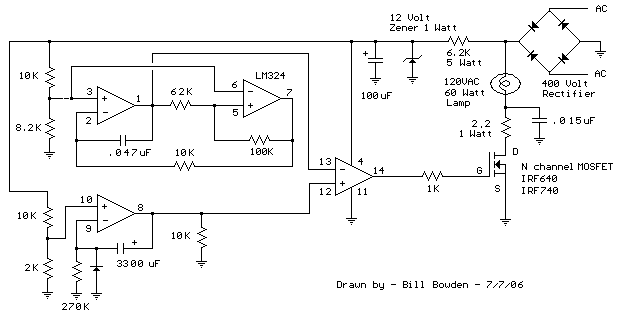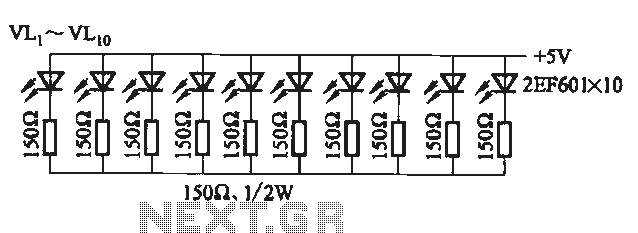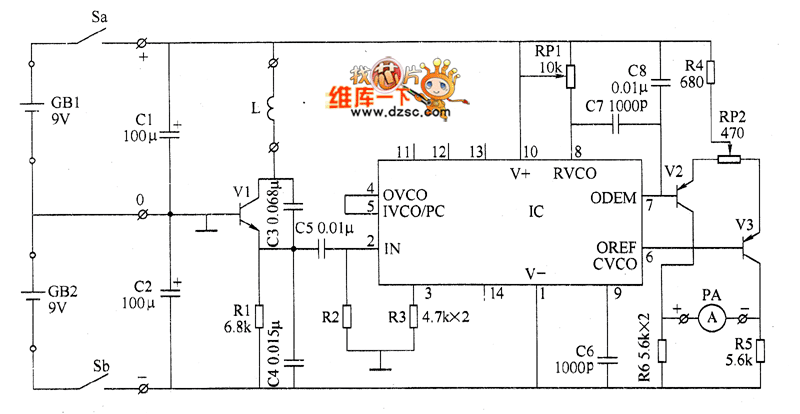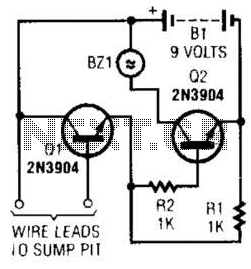
Sunrise Lamp circuit

This circuit gradually illuminates a 120VAC lamp over an approximate 20-minute period. A bridge rectifier converts the AC voltage to 120V DC, supplying power to the MOSFET and the 60-watt lamp. A 6.2K, 5-watt resistor along with a Zener diode is utilized to reduce the voltage to 12 volts DC for circuit power. The bridge rectifier should be rated for at least 200 volts and 5 amps. During operation, a 700 Hz triangle waveform is generated at pin 1 of the LM324, resulting in a slow-rising voltage at pin 8.
The circuit employs a bridge rectifier to convert the incoming 120VAC to a stable 120V DC output. This is critical for powering the MOSFET, which acts as a switch to control the lamp's illumination. The choice of a 60-watt lamp indicates that the circuit is designed for moderate lighting applications.
The use of a 6.2K, 5-watt resistor in conjunction with a Zener diode is a standard method for voltage regulation. The Zener diode clamps the voltage to a safe level of 12V DC, ensuring that the circuit's components receive the appropriate voltage for reliable operation. The resistor limits the current flowing through the Zener diode, preventing it from exceeding its power rating.
The bridge rectifier should be rated for at least 200 volts and 5 amps to provide a safety margin and ensure reliable operation under various conditions. This rating allows the rectifier to handle potential voltage spikes and ensures that it can support the load without overheating.
The LM324 operational amplifier is used to generate a 700 Hz triangle waveform at pin 1. This waveform is essential for controlling the rate of voltage increase applied to the lamp. The slow-rising voltage at pin 8 of the LM324 allows for a gradual illumination of the lamp, creating a soft start effect that can be visually appealing and reduces the stress on the lamp's filament.
Overall, this circuit can be effectively utilized in applications where gradual lighting is desired, such as in mood lighting or in scenarios where sudden bursts of light could be jarring. Proper component selection and ratings are crucial for ensuring the longevity and reliability of the circuit in practical applications.In this circuit, a 120VAC lamp is slowly illuminated over a approximate 20 minute period. The bridge rectifier supplies 120 DC to the MOSFET and 60 watt lamp. A 6.2K, 5 watt resistor and zener diode is used to drop the voltage to 12 volts DC for the circuit power. The bridge rectifier should be rated at 200 volts and 5 amps or more. In operation, a 700 Hz triangle waveform is generated at pin 1 of the LM324 and a slow rising voltage is obtained at pin 8..
🔗 External reference
The circuit employs a bridge rectifier to convert the incoming 120VAC to a stable 120V DC output. This is critical for powering the MOSFET, which acts as a switch to control the lamp's illumination. The choice of a 60-watt lamp indicates that the circuit is designed for moderate lighting applications.
The use of a 6.2K, 5-watt resistor in conjunction with a Zener diode is a standard method for voltage regulation. The Zener diode clamps the voltage to a safe level of 12V DC, ensuring that the circuit's components receive the appropriate voltage for reliable operation. The resistor limits the current flowing through the Zener diode, preventing it from exceeding its power rating.
The bridge rectifier should be rated for at least 200 volts and 5 amps to provide a safety margin and ensure reliable operation under various conditions. This rating allows the rectifier to handle potential voltage spikes and ensures that it can support the load without overheating.
The LM324 operational amplifier is used to generate a 700 Hz triangle waveform at pin 1. This waveform is essential for controlling the rate of voltage increase applied to the lamp. The slow-rising voltage at pin 8 of the LM324 allows for a gradual illumination of the lamp, creating a soft start effect that can be visually appealing and reduces the stress on the lamp's filament.
Overall, this circuit can be effectively utilized in applications where gradual lighting is desired, such as in mood lighting or in scenarios where sudden bursts of light could be jarring. Proper component selection and ratings are crucial for ensuring the longevity and reliability of the circuit in practical applications.In this circuit, a 120VAC lamp is slowly illuminated over a approximate 20 minute period. The bridge rectifier supplies 120 DC to the MOSFET and 60 watt lamp. A 6.2K, 5 watt resistor and zener diode is used to drop the voltage to 12 volts DC for the circuit power. The bridge rectifier should be rated at 200 volts and 5 amps or more. In operation, a 700 Hz triangle waveform is generated at pin 1 of the LM324 and a slow rising voltage is obtained at pin 8..
🔗 External reference





